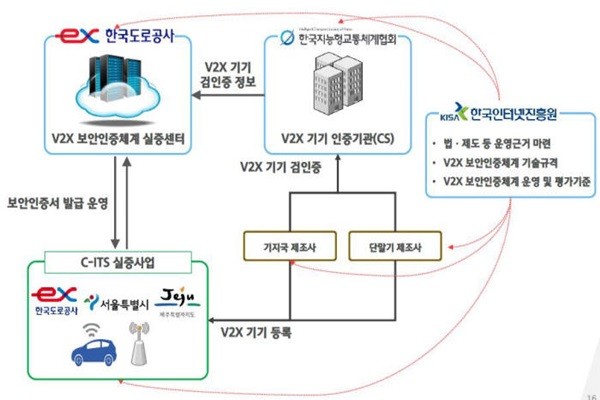South Korean Government is setting out to enhance infrastructures in South Korea to implement cooperative automated driving along with expanding projects for testing self-driving technology. It is going to prepare security systems so that vehicles and vehicles and vehicles and infrastructures can safely communicate with each other and strengthen infrastructures that are necessary for cooperative automated driving.
Until now, the government’s policies have been focusing on controlling vehicles closely and establishing V2X (Vehicle to Everything) cooperative automated driving system. From now on, the importance of technologies for commercializing security systems and protocols on telecommunication along with various demonstration projects will be emphasized. Enhanced infrastructures will be important for R&D and demonstration project.
◊Security to be the biggest issue for cooperative automated driving
It is expected that security business related to V2X will be very important this year. Hackers are lurking to target cooperative automated driving technology as it depends on sharing of information through telecommunication. There is a chance that hackers will look to impede autonomous driving by stealing traffic information and information on the location of cars that are shared by vehicles and base stations in real time and cause traffic accidents.
In order to prevent such situations, Ministry of Land, Infrastructure and Transport (MOLIT) has started a demonstration project for V2X security authentication system to protect cooperative automated driving technology. This system will allow telecommunication only between vehicles and base stations that are confirmed and it will also anonymize personal information and prevent falsification of messages. MOLIT established a roadmap last year and it is going to carry on development and demonstration on full-scale starting from this year and research into relevant laws at the same time.
Korea Expressway Corporation will establish a system for pilot center while Korea Internet & Security Agency (KISA) will research into relevant legal systems in order to introduce a security authentication system and develop technical standards as well. Intelligent Transport Society of Korea will standardize device verification and certification standards and procedures and connect these standards and procedures with the verification and certification systems for C-ITS (Cooperative Intelligent Transport Systems). In areas such as Seoul and Jeju where C-ITS is tested, V2X security authentication system will also be tested at the same time.
In addition, MOLIT has also started a five-year R&D project to operate a comprehensive security system for cooperative automated driving road traffic system. Purpose of this project is to develop security guidelines and comprehensive security authentication system for infrastructures of cooperative automated driving road traffic system and to establish a testbed along with the security control system for cooperative automated driving environment road traffic system. Korea Expressway Corporation will oversee the project while KISA, Dream Security, Korea Information Certificate Authority, PENTA Security, Mirae Technology, Igloo Security, and Atto-Research will participate in the development process.
Cloud SDDC (Software-Defined Data Center) and network virtualization technology were introduced to streets near Daejeon and Sejong that are the first ones to be applied with C-ITS. Efficiency of C-ITS has improved recently as edge computing was applied by National Information Society Agency (NIA). Edge computing indicates a distributed computing in order to process important data in real time. Because real-time processing is important for cooperative automated driving infrastructures as they are widely spread out geographically and involve human life, edge computing is the optimal technology for cooperative automated driving. SDN (Software Defined Network) has been enhanced in order to have stable edge computing. Anonymity service is also performed by edge computing equipment.

◊Cooperative automated driving to require many advanced projects
In order to commercialize autonomous vehicles, there has to be a harmony between sensors and controls of a vehicle, accurate road map, and telecommunication infrastructures for V2X. There are many projects that need to be done in order to establish an environment for cooperative automated driving.
Accurate road map indicates a 3D map that allows an autonomous vehicle to understand its location on its own and recognize surrounding roads and traffic signs. It is absolutely needed as car sensors cannot be trusted 100% and road infrastructures along with lanes are not enough to depend only on car sensors.
There will be a cooperative system this year in order to create an accurate road map. In 2019, 14 public agencies and private companies such as MOLIT, automotive manufacturers, and cartographers formed a cooperative public-private system to create an accurate road map together. Although the government created a 5,500km road map mainly for highways last year, its road map is definitely not enough to cover 110,000km of every road in South Korea. To solve this issue, MOLIT and other agencies and private companies will create a joint platform this year. “We are currently looking into establishing a joint corporation by developing this cooperative system.” said a representative for MOLIT.
Discussion about telecommunication standards for stable telecommunication service will also be a hot issue this year as mobile telecommunication-based C-V2X (Cellular V2X) technology is quickly becoming a general trend globally. Although there are demonstration projects carried out mostly for DSRC (Dedicated Short-Range Communications) and WAVE, private investments cannot be ignored when it comes to constructing a national network. This is one of main reasons why 5G network is emerging as a general trend. Chinese Government has already decided to establish C-V2X while South Korean Government and the U.S. Government are debating between C-V2X and DSRC. Generally, paid services are more preferred over free services within private mobile telecommunication areas.
There also needs to be a certification system to determine whether a vehicle or a device can perform smooth telecommunication. As of now, this test can be done through an interoperability test held once per year by MOLIT or tests held by foreign events.
“There needs to be a certification system in South Korea as it is inconvenient for us to go overseas to go through tests whenever we develop parts related to automated driving infrastructures.” said a representative for the industry.
Staff Reporter Mun, Bokyung | okmun@etnews.com